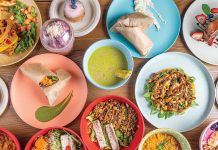
In the United States, the government regulates every food we eat to ensure its safety. The U.S. Department of Agriculture (USDA) oversees meat, poultry, and eggs, while the Food and Drug Administration (FDA) is responsible for dairy, seafood, produce, processed foods, and drugs.
In the U.S., the government issues financial benefits in the form of subsidies to farmers, mainly those producing corn, wheat, soy, dairy, meat, and sugar. Essentially, our government pays farmers to grow what the government wants them to grow, in the manner in which the government wants them to grow it and at what efficiency. Unfortunately, as a means of making as much income as possible in the shortest amount of time, many farms use methods to expedite and capitalize upon this process.
Antibiotics, growth hormones, pesticides, and GMOs all help maximize output while degrading our food quality. GMOs are genetically modified, living organisms whose genetic makeup has been altered in a lab to make them resistant to disease, increasing crop yields.
The end result? Our food has morphed into a distant relative of food, difficult for our bodies to recognize and harmful to our health. Here, I delve into what the labels mean, which ones to look for, and which to ignore.
Meat and Dairy
When it comes to beef, opt for cuts from local farms as opposed to factories, if you can find it. If not, the best choices are grass-fed, AGA (American Grassfed Association) certified, or certified grass-fed by AWA (Animal Welfare Approved). Grass-fed means that the animals are only fed grass from the day they wean from mother’s milk until the end of their life. They are also raised in open grass pastures, free to graze, and always antibiotic-free. The second-best choice is USDA certified organic. This means the cattle are fed 100-percent organic feed consisting of corn, grain, and grass and no antibiotics are administered. Avoid processed meats as these have chemicals, fillers, additives, and even high-fructose corn syrup.
Poultry and Eggs
The best choice for poultry is certified humane (see definition in sidebar). The second-best choice is certified organic. This signifies that the animals were raised on a 100-percent organic, non-GMO diet that did not contain animal by-product or antibiotics.
Fish
For fish, you have two options: wild or farmed. Farm-raised fish has higher fat, less protein, and fewer nutrients than wild. Farmed fish are often fed cornmeal, soy, and even canola oil. They’re also commonly given antibiotics due to their crowded conditions and risk of infection, as well as growth hormones. In addition to being lower in saturated fat and calories, wild fish is higher in heart-healthy omega-3 fatty acids, vitamins, and minerals. The best label to look for is MSC (the Marine Stewardship Council).
Produce
For produce, there’s either organic or conventional. Organic produce is grown on soil that has not been treated with substances like pesticides and fertilizer. All organic produce is non-GMO. Conventional produce is often subsidized, and its farming practices involve pesticides, usually GMOs, synthetic fertilizers, antibiotics, and hormones. These have been shown to cause hormonal imbalances, chronic inflammation, and chronic disease.
Common Labels Defined
Cage-free: Cattle are required to have outdoor space. Chicken and other poultry are raised in pens in “houses” and given access to 1 to 1 1/2 feet of floor space. This could be grass, gravel, or concrete.
Free-range: Animals are given access to 2 feet of outdoor space.
Certified Organic: Animals are fed a 100-percent organic diet, free of hormones and antibiotics. All organic chicken is free-range.
Certified Humane: Animals are never kept in pens, crates, or cages; are given plenty of outdoor access; and are not fed growth hormones or antibiotics.
Grass-fed: Animals are given only grass after weaning off milk.
Natural or All Natural: This term isn’t regulated, so it holds no weight. Initially, it referred to food that didn’t contain artificial ingredients, but it’s meaningless when used to describe meat or poultry.
Fresh: The meat or fish has never been frozen.
Non-GMO: A law was passed in 2016 requiring manufacturers to disclose GMO ingredients. Look for this stamp when buying anything.

Whole Roasted Chicken Recipe
Crispy-skin whole chicken cooked in a cast-iron skillet with roasted carrots, mushrooms, shallots, apple, and fennel
Ingredients:
3-5 lb. certified humane, certified organic chicken
1 lemon, sliced with seeds removed
3 sprigs of thyme
3 sprigs of rosemary
4 cloves of garlic, divided into 2 chopped and 2 crushed
4 large carrots, peeled and chopped
2 cups of sliced shitake mushrooms
3 shallots, peeled and chopped
1 fennel bulb, stems trimmed and bulb cut into quarters or wedges
1 apple (Honeycrisp or Fuji is best), cored and diced
3 tbsp. olive oil, divided

Preheat oven to 400. Combine chopped vegetables and apple in a bowl and toss with 2 chopped garlic cloves and 1 tbsp. of olive oil and set aside. Pat chicken dry, removing any giblets in the cavity and untying the legs. Stuff cavity with thyme, rosemary, lemon slices, and 2 crushed garlic cloves. Rub outer skin with 1 tbsp. olive oil and a sprinkle of sea salt.
Lay chicken breast side down onto an unheated cast-iron skillet. Turn burner to medium-high heat and cook chicken for 8 minutes. (I’ve found heating from a cold cast iron yields the crispiest skin.) After 8 minutes, turn heat off, carefully flip your chicken breast side up, and retie the legs. Add in your chopped vegetables, tucking them around the chicken. Drizzle with remaining 1 tbsp. olive oil.
Transfer to oven and roast for 45 minutes to an hour. Remove from oven when chicken’s internal temperature reaches 160. Let rest for 5 minutes. Transfer to a platter, arranging roasted vegetables around the chicken. Salt and pepper to taste.










Facebook Comments